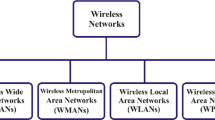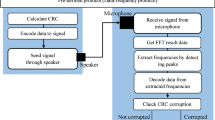Abstract
For communicating short data sequences over small distances, the use of devices with conventional wireless radio frequency interfaces requires standardized hardware, dedicated infrastructure and appropriate Link/Network layer protocols. To address challenges associated with these requirements, a communication mechanism using devices which support simple audio interfaces (speakers and microphones) is proposed using the upper audio band (UAB) of frequencies (16–20 kHz). Devices with audio interfaces can be deployed in a personal area network for communicating at low data rates over small distances. Multi-tone FSK modulation is used for transmitting Reed–Solomon encoded data over the UAB. For peer-to-peer communication applications, a sensing mechanism is enabled on the receiving device to sense for empty time–frequency slots and schedule its data transmission at the appropriate times. A system prototype is developed using portable speakers and smartphones with sensitive microphones. The effective throughput of the modem is evaluated for different sensing durations and distances. Ad-hoc peer-to-peer networks can be enabled between mobile devices for communicating short data sequences based on the UAB modem.











Similar content being viewed by others
References
Lopes, C. V., & Aguiar, P. M. (2001). Aerial acoustic communications. In 2001 IEEE Workshop on the Applications of Signal Processing to Audio and Acoustics (pp. 219–222).
Nakashima, Y., Matsuoka, H., & Yoshimura, T. (2006). Evaluation and demonstration of acoustic OFDM. In Fortieth Asilomar Conference on Signals, Systems and Computers, ACSSC’06 (pp. 1747–1751).
Yun, H. S., Cho, K., & Kim, N. S. (2010). Acoustic data transmission based on modulated complex lapped transform. IEEE Signal Processing Letters, 17, 67–70.
Lai, L., El Gamal, H., Jiang, H., & Poor, H. (2011). Cognitive medium access: Exploration, exploitation, and competition. IEEE Transactions on Mobile Computing, 10, 239–253.
Conway, J. H., & Sloane, N. (1998). Sphere packings, lattices and groups. New York: Springer.
Matz, G., & Hlawatsch, F. (2003). Wigner distributions (nearly) everywhere: Time–frequency analysis of signals, systems, random processes, signal spaces, and frames. Signal Processing, 83, 1355–1378.
Abeysekera, S. S., & Boashash, B. (1991). Methods of signal classification using the images produced by the Wigner–Ville distribution. Pattern Recognition Letters, 12, 717–729.
Hayes, M. H. (2009). Statistical digital signal processing and modeling. New York: Wiley.
Boashash, B., Lovell, B., & White, L. (1987). Time–frequency analysis and pattern recognition using singular value decomposition of the Wigner–Ville distribution.
Stoica, P., & Moses, R. L. (2005). Spectral analysis of signals. Upper Saddle River, NJ: Pearson/Prentice Hall.
Kim, J., & Andrews, J. G. (2010). Sensitive white space detection with spectral covariance sensing. IEEE Transactions on Wireless Communications, 9, 2945–2955.
Zeng, Y., & Liang, Y.-C. (2009). Eigenvalue-based spectrum sensing algorithms for cognitive radio. IEEE Transactions on Communications, 57, 1784–1793.
El Karoui, N. (2007). Tracy–Widom limit for the largest eigenvalue of a large class of complex sample covariance matrices. The Annals of Probability, 35, 663–714.
Botev, Z., Grotowski, J., & Kroese, D. (2010). Kernel density estimation via diffusion. The Annals of Statistics, 38, 2916–2957.
Garth, L. M., & Poor, H. V. (1994). Detection of non-Gaussian signals: A paradigm for modern statistical signal processing [and prolog]. Proceedings of the IEEE, 82(7), 1061–1095.
Sinha, R., Balamuralidhar, P., & Bhujade, R. (2012). An upper audio band based low data rate communication modem. In 2012 6th International Conference on Signal Processing and Communication Systems (ICSPCS, pp. 1–8).
ETSI TR 102 682 reconfigurable radio systems: Functional architecture. ETSI TR 102 682.
Ghasemi, A., & Sousa, E. S. (2008). Spectrum sensing in cognitive radio networks: Requirements, challenges and design trade-offs. IEEE Communications Magazine, 46, 32–39.
De Domenico, A., Strinati, E. C., & Di Benedetto, M.-G. (2012). A survey on MAC strategies for cognitive radio networks. IEEE Communications Surveys and Tutorials, 14, 21–44.
Cheng, M. (2011). The LAME project. Retrieved October, 2011, from http://lame.sourceforge.net/index.phpv3.99.
Author information
Authors and Affiliations
Corresponding author
Rights and permissions
About this article
Cite this article
Sinha, R., Balamuralidhar, P. & Bhujade, R.M. A reconfigurable upper audio band modem for data communication between mobile devices. Analog Integr Circ Sig Process 78, 669–682 (2014). https://doi.org/10.1007/s10470-013-0175-y
Received:
Revised:
Accepted:
Published:
Issue Date:
DOI: https://doi.org/10.1007/s10470-013-0175-y




